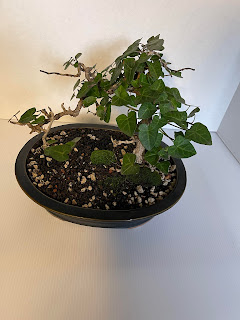Hello to all and a very Happy Thanksgiving. Sage as a bonsai who would have ever thought? Oh excuse me I did.
Sage is a wonderful craggily looking material in the trunk and it is indigenous to most high and even some low Deseret areas of America and other areas of the world. I worked on a ranch in the state of Nevada years ago when I was young. The one small room little bunk house I lived in had an old pop belly stove and I would burn sage brush in it and believe me when I say sage makes for a quick and very easy hot fire.
The high desert of Nevada gets mighty cold at night and in real early morning time but that sage could warm up my entire little cabin in a heart beat and have my coffee brewing in a short time. Sage is very aromatic and the oils in the woody material will make it catch fire readily. The native tribes used sage for many different things and also for seasoning various foods. They made mats for there dwellings out of the sage wood as sage will strip fairly readily and can then be woven.
I did not know but the sage plant can actually talk to one another. No not really talk but they give off a sort of special chemical sent that can be recognized by other sage plants in times of stress or pest infestations and the like so if one is being attacked it can send out the sent and others are for warned and then can actually infect the invaders.
I was lucky to get this one and its been in my collection now for about ten years. I have no idea how old it is as it is a collected plant and only god knows its age. Sage leaves are pretty small and very pretty light muted blue gray looking. The sage plant can go a long time with out water as it is accustomed to that in the high deserts.
My sage tree is in a cascade style potting and in a nice dark blue pot and I have only transplanted it once since I have owned it.
The soil is my ready mix of pumice akadama, and lava rock. Almost all of my bonsai are planted in this same mixture only at different levels of akadama depending on the tree. Sage is truly edible and many animals and birds depend on it for extra food sources and nutrients, rabbits, mule deer, pronghorn and sage grouse. The sage grouse also use the brush for cover and shelter in times of need from other predator's. The young eat the seeds and the sage is a real true friend of the sage grouse.
Sage is in the family of Asteraceae and grows fairly prolific in the United states in many states and in many other countries.
This sage brush was collected in the high desert around Madras Oregon. The region is prolific with sage. It was collected on a fishing trip to the area. The sage can produce small yellow flowers in early spring and if you rub a sprig in your finger tips and smell it then your in for a real nice treat and or surprise.
A lot of sage gets destroyed by wild fires every year and there have been ecology experts from the land management offices actually getting inmates in the Oregon Penial system to grow the plants to reforest a lot of the areas affected. It is said that they grew more 90 thousand plants alone in the year 2017 and are still making it happen to this day. The sage grouse is fast becoming close to being added to the endangered act and truly do depend on the sage for their survival.
If your out in any area where sage grows you may want to try and collect one. But always make sure you get permission first from a local forest service station area. Or try to get some seeds and plant them to grow one or many. If you do get permission to collect one then be especially careful to dig a wide area around the plant while trying to up root it and make sure you get as much of the root as possible.
Collect some of the actual soil where you dig the tree up and use that as its beginning substrate planting then later after your sure it is established good and not going to perish then move it on to the pumice, lave rock and akadama mixture. Sage can live to over 100 years old if cared for properly.
Good luck and I hope you have a wonderful Thanks Giving where ever you are in the world.





